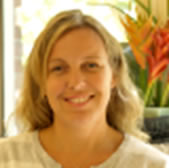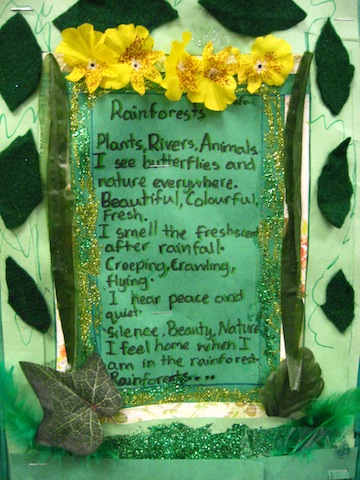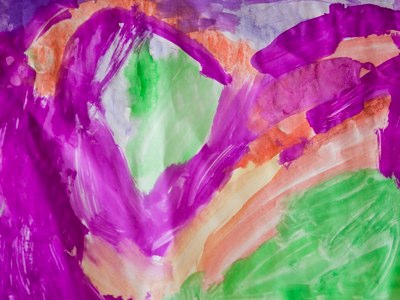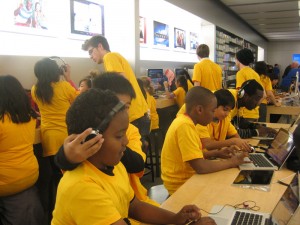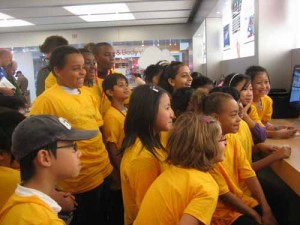In my last blog, I talked about trying to get students to meaningfully assess how and what they learned. As a crucial follow-up, I make sure to spend some one-on-one time with every student to discuss their progress throughout the term. As a rotary teacher who sees three classes of 30 plus students a day for 42 minutes (a full-time teacher would then see approx 180), I find that it’s challenging to establish a personal relationship with each one of them. Ensuring that I build in the time to sit down and talk to each one of them is a must. I plan around an activity (usually French skits) where students are focused, self-directed and engaged to minimize interruptions with questions. Over the course of the week, I spend between 3 to 5 minutes (not nearly enough I know), where we have each other’s undivided atttention talking about their results for the term, their strong points as students and concrete, realistic steps they could take to improve. Finally, it is also a great opportunity to just shoot the breeze. It’s been my experience that students respond more positively to this individual attention and it allows them to more fully appreciate and understand their mark on their report card. Most importantly, it allows for each of you to connect on a personal level.
Blog
Sleep
Like Roz, since September, I have been up really late most nights planning, organizing, assessing, and trying to keep up with board and school initiatives. Most nights, I go to bed t feeling good about the engaging activities I have planned for my students. Then the alarm rings 5 – 6 hours later…
I find myself driving to school feeling beat. What a terrible way to start a day. I have come to realize that my great lessons turn out to be “not so great” when I can’t get myself out of second gear all day long. I have decided to pack it in earlier most nights. I may go to bed a little less planned, but I am getting 8 hours sleep. Now, more often than not, my lessons turn out the way they were planned because I have more energy to move and think…and most importantly, I enjoy my students and their abundant energy so much more!
Meaningful Connections
Learning in a classroom has its challenges and restrictions, especially for a diverse group of learners who like a hands on approach. I often hear adults say that they would rather do something than read about it. Children likely feel the same way, though don’t express it in those words. Experiences like a visit to the Apple Store (as Carmen blogged earlier), are opportunities that connect the student’s learning with a realistic context. Some excursions are very controlled and are presented as a program, but an excursion that connects learning in the classroom with a real context or environment is more meaningful for the learner.
When planning for a combined grade one and two class, I looked for commonalities in the curriculum that could be approached similarly or in the same context. At the time of planning, I was also reading a variety of articles that ranged in subject from nature deficiency in children to mindfulness in the classroom. I came across one article that demonstrated the value of science notebooks for observation and inquiry. So, in September every student in my classroom received a blank notebook that was introduced as a “field journal”. Every week our class takes our science lesson outside with field journals to observe what we have learned in a real world setting. The children date each entry and record their observations and questions using pictures and words. A ravine that is located within a block from our school provides a rich context when looking for signs of the water cycle or evidence of the sun’s energy. We have also carried our journals around the school to find examples of energy use and consumption by tracking how many classrooms use their lights, some lights, or rely only on the light from the windows. The use of the field journals is effective because they are purposeful and the children are investigating their environment with specific intent. When we discuss their observations back in the classroom, the children learn from each other as their perspectives or findings differ. Often, new questions arise, which leads to more investigation or research.
Although it has only been two months since the introduction of field journals, it has become routine to our science program and the children look forward to applying the knowledge acquired in the classroom to their own natural and constructed surroundings. The journals integrate concepts and skills that we learn from other areas of the curriculum such as language, visual arts, and mathematics. But best of all, the children are visibly engaged in their learning while making meaningful connections to their world.
Weaving Inspiration Into the Curriculum
One of the most rewarding aspects of teaching is the creativity and inspiration we can weave into the curriculum to bring deep and meaningful learning experiences for our students (and ourselves!). This past week my class enjoyed an art lesson integrated with media, oral communication, and writing expectations. It served as a perfect example of how students become more engaged when our lessons are filled with what inspires us.
A friend of mine emailed me a phenomenal video depicting the sheer beauty, simplicity, and breath-taking scenery found in nature around the world. It moved me deeply and I knew I had to somehow share it with my students in a meaningful way. I decided to use it as the foundation for an art lesson. We have been exploring cool and warm colours, texture, and patterns. We watched the video and had a class discussion using sensory prompts (I see…, I hear…, I feel…, I smell…). The descriptions were profound and all the students were eager to share their thoughts and feelings!
Next, students chose an aspect of nature (ocean, rainforest, sunset, etc.) to create a frame for a sensory poem using warm/cool colours and different textured paper.
Lastly, using a template as a guide, students created their sensory poem. Students were encouraged to experiment with word choice and powerful images to portray their scene. I cannot begin to describe how excited and proud they were to share their art and poetry with me and each other! At the end of the experience, they asked to watch the video again. I gladly shared it once more and silently thanked my friend for the inspiration that created a beautiful teaching opportunity.

Rainforest
plants, rivers, animals
I see butterflies and nature everywhere
beautiful, colourful, fresh
I smell the fresh scent after rainfall
creeping, crawling, flying
I hear peace and quiet
silence, beauty, nature
I feel at home in the rainforest
Rainforest
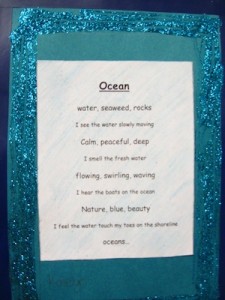

One student at a time…
Sometimes when I look at my students, I wonder: how can I meet the needs of everyone?
Will I be able to support the student who is feeling bullied or the student who struggles to grip a pencil? Will I figure out the best way to explain to a parent that we are focusing on inclusion and gender equality when that may be contrary to how she was educated?
And the answer that comes to mind is definite: not every minute of every day.
But…I can start with one student at a time.
Take “Matthew”. He has been diagnosed with ADHD and takes medication daily to help him manage impulse control and the challenges he has with filtering his thoughts. Matthew’s medication is time-released and so the first few hours of the morning are very difficult for him until things start to ‘kick in’, as he calls it.
So, I tried a few things. I gave him time to do something hands-on when he first came in, but he became frustrated. I used my gym time first thing in the morning to help him work through some of his excess energy, but it seemed to distract him more.
Then last week, I decided to make a morning message for him. I recorded a personal greeting that gave him information about what we would be doing that morning and how he might be successful in those tasks. As he listens, it helps him to access an inner voice he knows he has, but he just can’t hear yet.
Of course, there is no magic answer for Matthew or for any of my kids for that matter. Like us, they will have up and down days and sometimes things won’t work. But maybe if I take on one student at a time, I can start to meet their needs…and mine.
The Power of Partnership
Like Roz and Sangeeta, I too am figuring out ways to strike a balance between work and life amidst the organized chaos of teaching. Teaching a different grade each year is a challenge. Every day, the joy of teaching is a juggling act: IEP’s, managing behaviour, integrating lessons, preparing materials and assessments, chasing down assignments, reporting, communicating with parents… It has been said that it takes a village to raise a child, and I believe us teachers are doing our students and ourselves a disservice if we try to do it in the isolation of a single classroom.
Being new to a school can be a little isolating at first because one hasn’t had the time to develop the strong collegial relations that an established staff already has. Though every school I have taught at has welcomed me warmly, I have found that it takes some time to learn who your ‘go to people’ can be which can be complicated further if you’re using your lunch hour for work and others are busy making the most out of their time as well. Over time, I have learned that to start building collegiality and partnership is to start by asking. I ask questions. I ask if teachers are interested in collaborating. I ask if they can share. I ask if we can meet. And I offer too. I offer what I have and the skills that I bring. After all, partnership is give and take. Through the power of collaboration I am learning that I able to be more attuned to the things that need to be done, while feeling less fragmented by all of the balls that are flying in the air.
This year, I have been collaborating closely with one of my colleagues who has inadvertently become my mentor. We meet on a common prep time once a week and map out what our week looks like, share materials and resources and brainstorm ideas together. We build on each other’s ideas, pull out books to read, make to do lists, refer each other to helpful information sites, pull what needs to be photocopied, divide the labour and regroup halfway through the following week to reflect on how the students are doing, what we found challenging and share with each other what we would do differently. It is a wonderful partnership.
I can’t even begin to share what a relief it is to be able to collaborate so closely with an experienced teacher on such a regular basis. For one, my thoughts aren’t going into overdrive figuring out ways to organize the multitude of information that I come across daily. Because we approach the teaching of our respective classrooms as a shared responsibility, I can worry a little less that I may not have certain materials in the classroom to do an art lesson, or that I am missing information that needs to be communicated in a newsletter or calendar to parents (which is likely to happen if you’re new to a school or a newly hired LTO). I have a ‘go-to-person’ that can come to my aid or fill in the blanks, and this has been so good for my peace of mind. I am sleeping better and have the energy to accomplish all of the things that I set out to do with my students , and I think it is making me a better teacher.
“Targeting” Reflection Through Self-Assessment
As reporting time is fast approaching, I’ve always found it vital that students not only have an idea of where they stand (based on marked assignments) but that they understand how they got there. You would think that with criteria fully explained through various assessment tools and ongoing feedback, students would have a clear idea of their progress. However, I’ve noticed that sometimes they tend to exclusively focus on the mark. Instead of always receiving feedback from the teacher, what is sometimes equally, if not occasionally more productive, is to provide an opportunity to analyze themselves as learners.
I find that using the “Bullseye-Hit or Miss?” questionnaire (see attachment ErinSelf-assment term 1), is effective since the concept of the bullseye in graphic form is engaging on a visual level. I’ve also discovered that for both the students and myself, it communicates a clear perspective without them being subjected to in-depth “reflecting”. Before returning it to me, I give them a chance to compare and discuss with a friend. Getting input from a partner they feel comfortable with tends to result in a more insightful action plan in the final part of the questionnaire. Once collected, I hang on to these to use in out one-on-one student conferences. More on that in my next blog.
Finding Opportunities for Learning Outside the Classroom
This week we participated in an excellent real world learning experience outside the classroom (and it was almost free!). My Grade5/6 class has been exploring biographies, memoirs, and looking at the features and format of recounts. We have also been using our MacBooks to support our learning in various ways. An opportunity arose to bring the two together by visiting an Apple store to learn how to create an iMovie in the form of a biography about each student. The entire trip, including transportation, came to $1.50 per student. It ended up being a meaningful, incredibly fun, and real world learning experience for everyone!
This year, our division is committed to creating as many of these powerful learning opportunities as possible for our students because the enthusiasm, eagerness, and results we see back in the classroom support the belief that applying concepts and new learning to real life experiences is what creates long-term understanding.
When you begin to explore all the possibilities to have students apply classroom learning and experience in a real world setting, with a little creativity and investigation, it’s amazing how many opportunities are out there! The only expense our students had was the bus trip to the Apple store for $1.50. In return they received lessons and support from a team at Apple, a free t-shirt, the opportunity to use the latest technology to create their iMovie, and a certificate of participation in the program! It can’t get better than that!
Students working with the crew at Apple
Students watching their video biographies!
Staying Connected
Similarly to Tina and Roz, I use different means of communication to stay connected with families throughout the year, mostly our classroom website, face-to-face contact, and agendas. It is difficult to limit yourself to one tool to suit the needs of all families. At the beginning of the year I send a paper newsletter and ask for email addresses to invite families to view our classroom website and receive updates from our weekly blog. This is a big hit in the community where I teach, as many parents like to get reminders on their mobile phones or sync our class calendar to their personal calendar. Most of the emails I receive are simple questions that require a simple and quick response, such as setting up interview times or confirming ad due date. Like Roz, if the request is something more delicate, I often call the parent and discuss the concern over the phone or set up a time to meet in person.
Since I teach a grade one and two class, I walk them each day to the outside door to meet their parents or sitters. The parents that I see daily or weekly can easily approach me with a quick question or I can provide an update without having to make time for the phone or computer. For example, I have a grade one student who has arrived in September with no English language. One or two days a week, her mother may ask me about something we have done in class that her daughter is trying to understand and has told her mother at home. With the mother there as the translator, we achieve quite a lot in a few minutes. These quick discussions are easier, more casual, and provide positive support for the student’s learning on a consistent basis (in addition to the support she receives in the classroom), which connects her learning to her home and family.
At my school, every student from grade one to six purchases an agenda in September. At first, I thought this was taking a step backward on my path to improve parent communication with the use of technology. Now, I realize it is just one more means of communication – not only between me and the parents, but it supports communication between the students and their parents when they refer to it together at home. I decided that if the children are all buying the agendas in my class, then we would make good use of them. So, when the students get settled at entry they first open their agenda and find the day’s date. We do quick math skills, talk about health and wellness while evaluating our feelings and assessing our exercise and eating habits for the week, in addition we use the calendar in the agendas rather than a shared calendar, and the students write reminders to themselves. I do not sign the agendas daily, but I do a quick walk around to either read, respond, or initiate a comment as needed. It has also helped with classroom management during the transition from entry to the time we meet together for our gathering circle. The children have learned to explore their agendas (agenda work), if my attention is focused on addressing a student concern or speaking to a parent at the classroom door.
Although keeping up a few forms of communication sounds like juggling balls in the air (and it sometimes is), it is the best way to meet the needs and include all families. By ensuring that you have communicated with parents about any concerns, your face-to-face communication during scheduled interviews will be easier for you and the parents!
Go-to-People
Thinking about Roz’s commitment to taking care of herself, I realize that one way I have been taking care of myself is by making a mental list of “go-to-people”.
In my classroom, my students have “go-to people” they can approach when they need some help: it may be someone who draws comics well or someone who likes to incorporate humour into their writing. But this concept isn’t limited to just kids…
There are a variety of colleagues I am learning from who I can go to when I need to talk about curriculum planning or when I have a student that I’m trying to reach. That’s the beauty of teaching: we are not alone working in our little cubicles, there are doors open to us and we need to take advantage of that, for our own peace of mind and wellness.
The relationships we nurture with our students is just as important as the relationships we nurture with our colleagues.
So, when you look around, who are your “go-to-people”???



